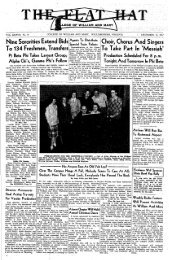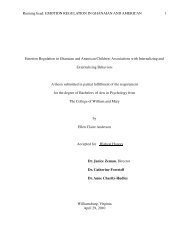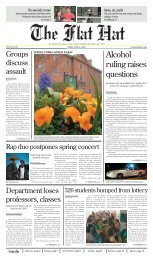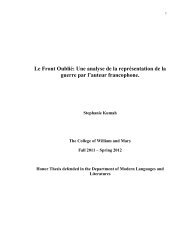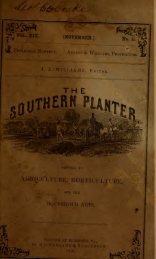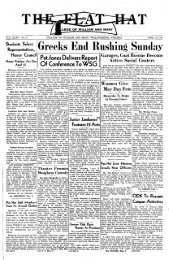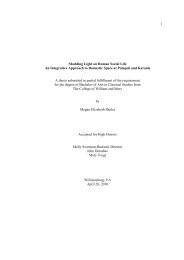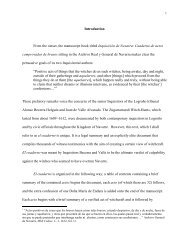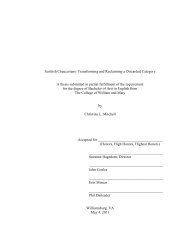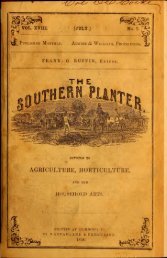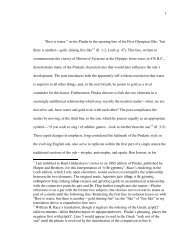Southern planter - The W&M Digital Archive
Southern planter - The W&M Digital Archive
Southern planter - The W&M Digital Archive
You also want an ePaper? Increase the reach of your titles
YUMPU automatically turns print PDFs into web optimized ePapers that Google loves.
1859.] THE SOUTHERN PLANTER. 411<br />
arable land, which thousands of our citi-<br />
zens have been taught to regard as inex-<br />
haustible, the gradual deterioration of the<br />
soil from a wasteful system by which the<br />
constituents of fertility are removed with<br />
each successive crop, without being restored<br />
by appropriate manures—a system based<br />
upon the desire for immediate gains, without<br />
thought of the sacred duty that devolves<br />
upon us to transmit the soil to our<br />
posterity, with undiminished productiveness,<br />
that it may sustain in comfort and happi-<br />
ness the unnumbered millions that are pres-<br />
ently to occupy our land ; these and simi-<br />
lar consideratians connected with the pres-<br />
ent and future prosperity of our country,<br />
appealing at once to the interest and the<br />
patriotism of the nation, may be so elabo-<br />
rated and diversified, and verified by the<br />
tables of the Census, that its returns shall<br />
teach us not simply lessons in political<br />
economy but lessons of daily duty, the ben-<br />
efits of which shall be reaped alike by the<br />
present and future generations.<br />
<strong>The</strong>re are various topics connected with<br />
x\merican Agriculture on which I would<br />
like to touch, did time permit me. One,<br />
the recent and rapid introduction of improved<br />
agricultural machinery soon probably<br />
to be followed by the use of steam<br />
plows and other machinery worked by the<br />
same motor, overcoming, to a great extent,<br />
the chief difficulty of the American farmer<br />
in the high price of labour ; that fea-<br />
ture of our agriculture which constitutes<br />
so marked and essential a difference between<br />
the practical agriculture of America<br />
and Europe.<br />
Another is the spread of agricultural<br />
science, through the efforts of the patent<br />
office distributing their reports and seeds<br />
gathered from Europe ; through the multi-<br />
plication of books and papers devoted to<br />
the subject, and by county, state and na-<br />
tional societies and farmers' clubs, in their<br />
frequent meetings, addresses, and exhibi-<br />
tions of agricultural implements and pro-<br />
ducts.<br />
What the country now most requires in<br />
reference to its agriculture, is, that its con-<br />
dition should be faithfully photographed in<br />
the returns to each Federal Census, and it<br />
will be for the Agricultural Section of this<br />
body to prepare well considered suggestions<br />
for the new schedule and submit them to<br />
the Federal Government. Such suggestions<br />
will appropriately come from the American<br />
Geographican and Statistical Society, in<br />
view of its national character and the scope<br />
of its labours; and such suggestions, judging<br />
from the past, the Federal Government,<br />
will cheerfully receive and carefully consider.<br />
Among the additional items which might<br />
advantageously be included in the schedules,<br />
I would suggest the following<br />
As regards parsons employed in farming.—<strong>The</strong><br />
proportion of the population thus<br />
employed of both sexes. <strong>The</strong>ir average<br />
life, as compared with that of persons liv-<br />
ing in towns, and of other trades.<br />
As regards capital employed in agriculture.—Not<br />
only the proportion invested in<br />
land, stock and implements, but the profit<br />
thereon received during the year immediately<br />
preceding the Census.<br />
As regards the farms.—Not only the improved<br />
and unimproved lands, and the proportion<br />
in meadow, pasture or tillage, but<br />
the number of acres of each farm that have<br />
been drained ; the number requiring drainage;<br />
the number drained during the last<br />
year; the cost of draining, and the value<br />
of the land before and after.<br />
In regard to the improvement or deterioration<br />
of the soil.—<strong>The</strong> average of each<br />
crop and cost of each per acre ; the average<br />
of bushels or tons to the acre, and the<br />
cash value of each on the spot.<br />
In regard to manures.—<strong>The</strong> amount, variety,<br />
and cost of those applied during the<br />
last year, and the rate of cost per acre.<br />
Other suggestions will doubtless, be made, a<br />
collation of which, by the Bureau of the Census,<br />
may afford us in future years, the means<br />
of tracing the progress of American agri-<br />
culture, and reading its actual condition at<br />
each decade, with the same facility with<br />
which a prudent merchant reads the past<br />
and present of his business in the carefully<br />
prepared balance sheet; and if the future<br />
of America shall continue to exhibit the<br />
same steadily progressive advance that we<br />
find in her past, the tabular results of each<br />
succeeding Census, dry and uninteresting<br />
as they may seem to those who shall see in<br />
them but columns of figures, will in fact<br />
develop the fulfilment of some of those<br />
prophesies of the coming wealth and splendour<br />
of the Western Continent, that when<br />
occasionally uttered by our far-seeing econ-<br />
omists, are apt to be regarded as the care-<br />
less dreams of visionary enthusiasts.<br />
Mr. President and Gentlemen, I<br />
cannot close this address without remark-



